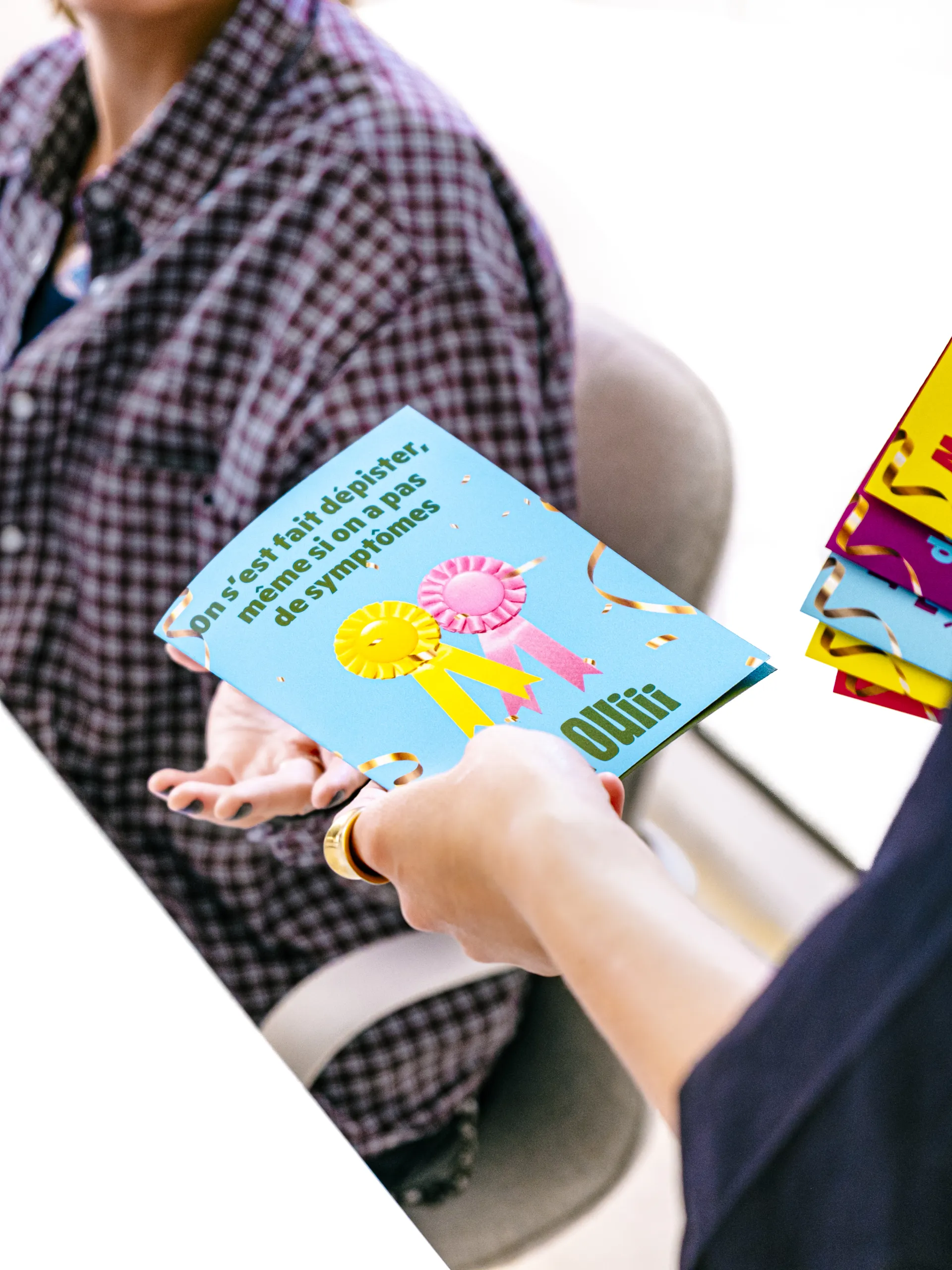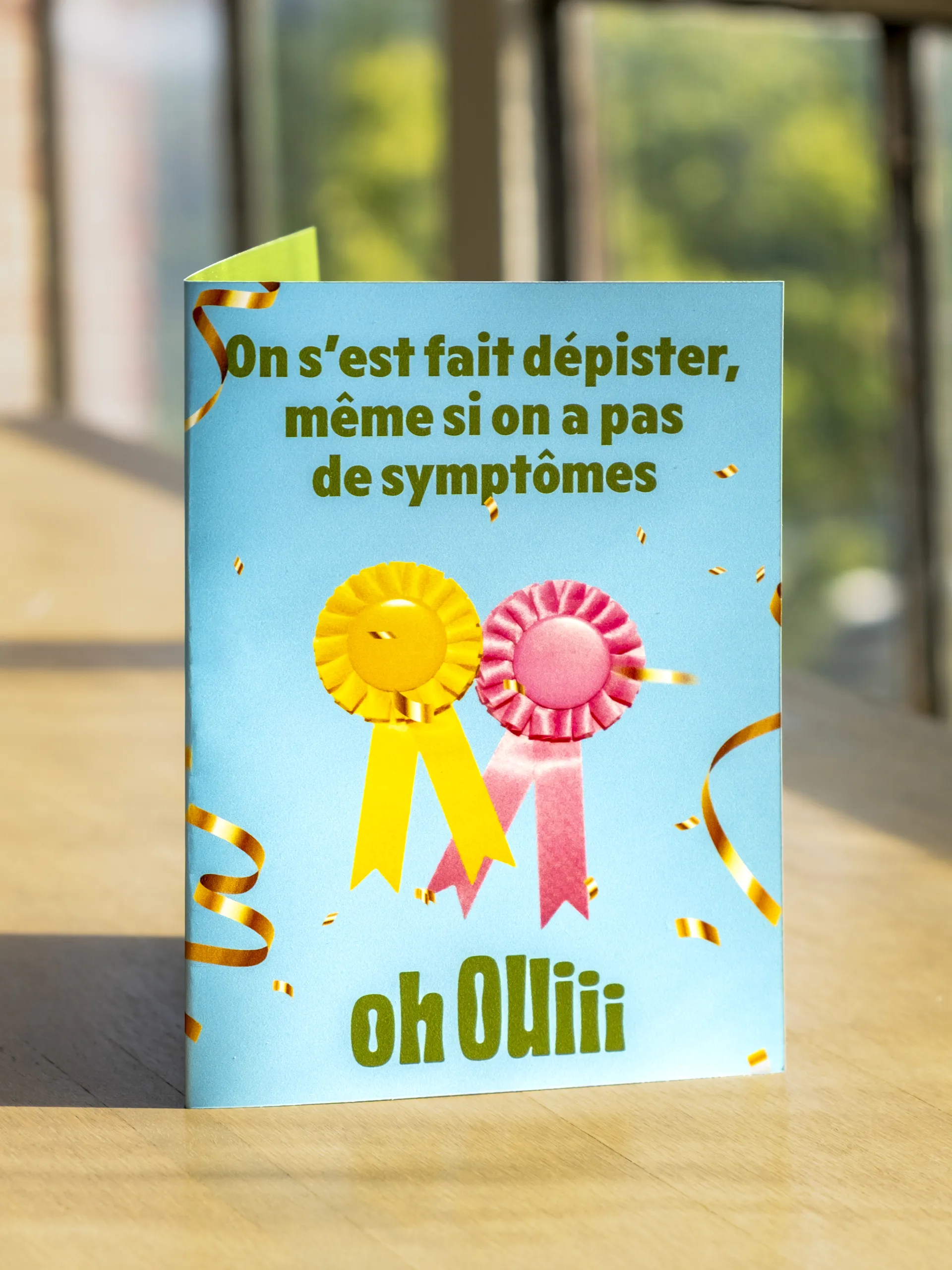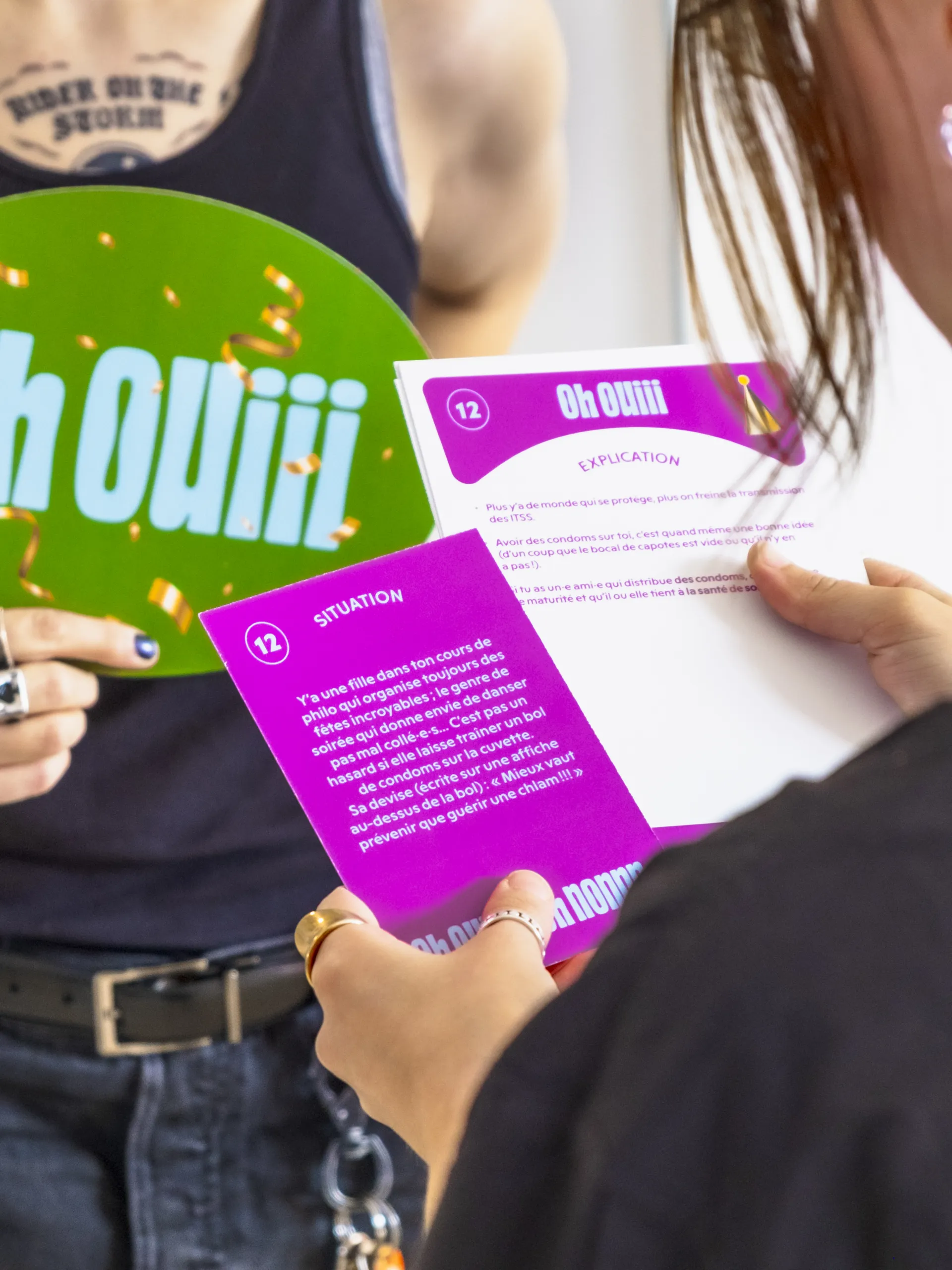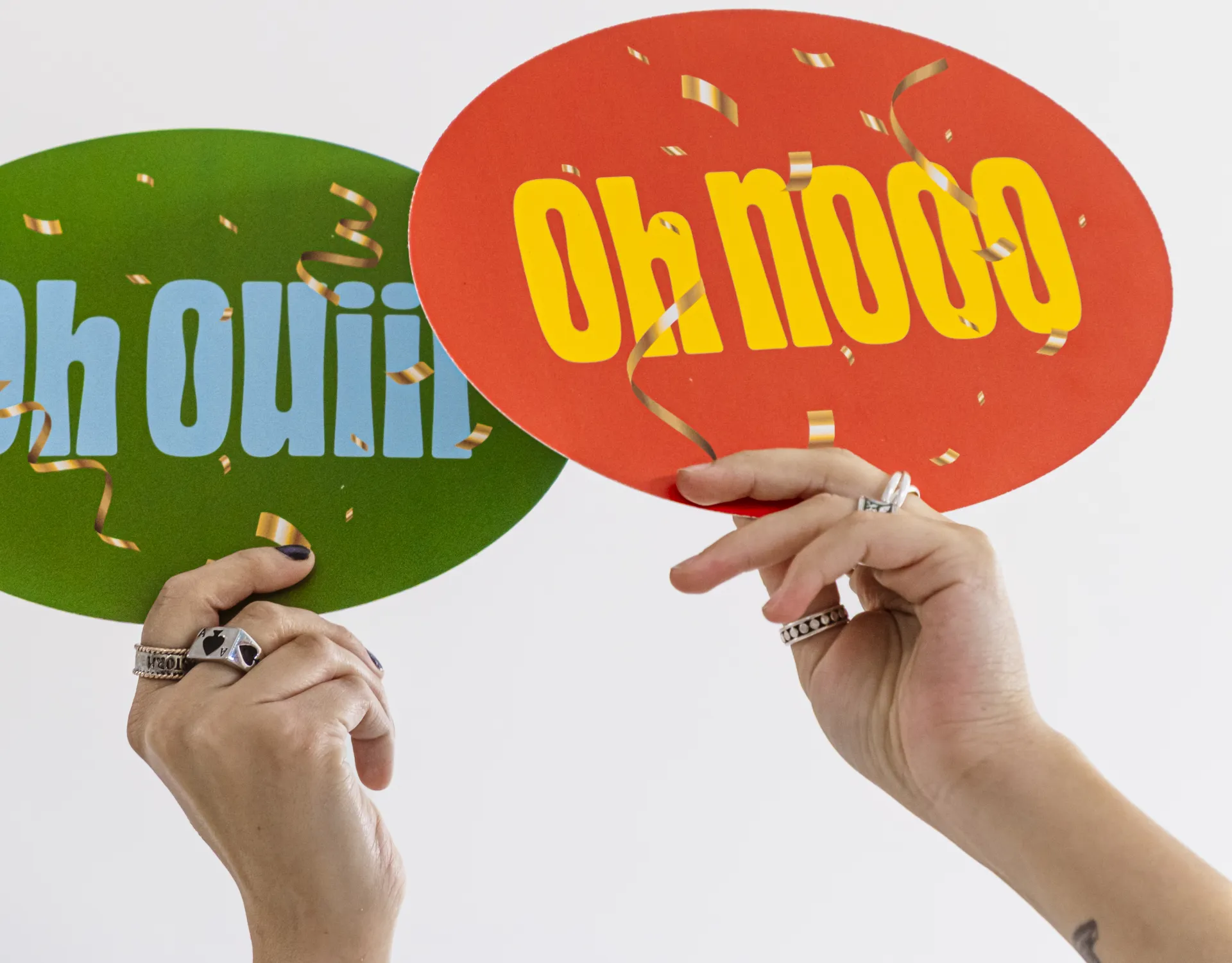On-campus activities
If you’re looking to build hype around Oh yesss, we’ve got a few fun-filled and entertaining ideas for you.
Because the project celebrates good habits, the proposed activities align with the spirit of celebration. These activities are intended to meet the project's objectives by connecting with students directly in their everyday surroundings.
Some activities are more passive and self-guided, while others rely on connection and interaction with fellow students.
Brochures designed as greeting cards
The greeting cards are brochures that highlight other positive aspects of the initiative that aren’t featured on the posters. These assets are a great complement to other assets.
This fun format relates to the initiative’s overall theme and reminds us that every positive step taken towards sexual health is one worth celebrating.
Inside every greeting card is a QR code that students can scan with their smartphones that drives them to the “good habit” on the Oh yesss website where they can find more details and practical tips.

How to use the greeting cards
Greeting cards can be placed or distributed everywhere on campus:
- on tables in the cafeteria
- in the atrium
- in the bathroom or on tables or counters of student cafés
- pinned to bulletin boards
- in your offices
- in waiting areas
- in student service centers
There are two ways to distribute them:
- Horizontally: Place a stack on a flat surface like a table or counter
- Vertically: Hang them up on a wall. Don’t hesitate to get creative with poster placements to create a type of “find the good habits” in your academic institution

Why use the greeting cards?
This initiative requires little preparation or resources. Because it’s more of a passive tool, these greeting cards might reach students who feel shy or are introverted and who might hesitate when it comes to participating in the initiative’s more engaging activities, such as the quiz or the interactive game.
We provide you with 10 greeting cards.
Each card measures 10 x 8 in. when opened, and 5 x 8 in. shut.
1. Print the cards
- Download the files.
- Use cardstock paper (stiffer than normal paper, but still bendable).
- Print double-sided on a slightly larger format to allow for bleed. We recommend a standard 11 x 17 inch format.
- Cut the cards to the final size by following the cut lines on the printed sheet.
2. Fold the cards
- Fold the cards in half (along the length) to close it.
- When closed, the card should be 5 x 8 in.
💡 Tip: For a clean finish, vivid colours, and precise folding, we recommend hiring a professional printing service—often they include cutting and folding for items like greeting cards.
Interactive game
Description
Hosted on the Oh yesss website, the game is presented in a “choose your own adventure” format. Players put themselves in the protagonist’s shoes and must decide on their behalf at various points throughout the game.
As the story progresses, topics like condom use and STBBI screening come up, prompting the player/character to choose what they feel is right.
The game gives players two options at the end of each chapter, and from there, they must decide how to proceed. Beginning with Chapter 5, the decisions focus on sexual health. Every choice affects how the story unfolds.
Solo or group play
Group
The majority decides the outcome, based on a real-time voting system. Disagreements can happen, which are a great way to open up discussions around healthy sex habits.
Solo
The story unfolds based on the decisions made by the player.
Duration
Approximately 8 to 10 minutes. Short enough to grab your attention, rich enough to make you think. Perfect for playing during a break between classes!
Why use this interactive game?
The interactive game offers an immersive, realistic, and participatory approach to sexual health. By following a story set during a party, participants can imagine themselves in a similar situation, which encourages them to reflect on what choices they would make about STBBI protection and testing. The ultimate goal is to celebrate wins, even when a person’s choices about sexual health choices are not entirely risk-free, as part of a harm reduction approach.
Game moderation
As the moderator, you’ll want to have access to a screen big enough for a large group to see. Participants can join via smartphone.
To get started, choose the “group play” option on the main menu and carefully read the instructions. A QR code will then appear on the screen that players must scan to participate.
Once they’ve scanned the QR code, a pop-up will appear on the top right-hand corner of the screen, indicating the number of players who joined. When everyone is ready to play, hit “start” to begin.
Read it aloud to make the gameplay more exciting and fun!
Bringing the activity to campus
Option 1
Play the game during class time.
Option 2
Set up a booth in a common area, welcoming small groups of students to come play at a time. Encourage them to participate with their friends. Project the game onto a screen or TV; the larger the screen, the more visible the game.
The outcomes
This interactive game has eight possible endings designed to get people talking about different topics and with different informational objectives.
Ending 1
“You search for Maëlle to see if she has a few condoms hiding somewhere.”
1. There’s nothing embarrassing about caring for your sexual health.
Feeling comfortable enough to ask others for condoms—even people you don’t know very well—not only protects you but helps normalize discussions about sexual health. Speaking up or asking for help breaks taboos while sending the message that taking care of yourself and others isn’t awkward.
2. Acknowledges the importance of condom availability—for themselves and others—while serving as a reminder that some people may face barriers to access or carrying them around.
Sex is not always planned, especially in party settings. So, having condoms at home when you’re hosting a gathering is a thoughtful way to show up for your crew. Keeping condoms handy in the bathroom, for example, sends a clear message that sexual health is a shared responsibility, not just an individual one.
3. Makes a habit out of checking a condom’s expiration date to see if it’s still in good condition.
Having some on-hand is important, but if they’re expired, then they’re much less effective, thus defeating the purpose.
4. Recommends limiting the use of flavoured condoms to oral sex, because using them for penetrative sex can cause irritation or infections because of the sugars or flavours they contain.
Ending 2
"You decide to meet up again the next day: a picnic in the park (right across from your house... right across from a box of condoms... yay!)."
1. Acknowledges that, in the heat of the moment, we can sometimes feel invincible—but taking a moment to talk about screening and understanding the risks can help you make informed sexual health choices.
Deciding to hold off on penetrative sex doesn’t have to kill the mood; instead, it can shift the energy and even build anticipation for next time.
2. Acknowledges that being in an exclusive relationship or having never had an STBBI doesn’t mean you’re immune from contracting one.
Ending 3
“Five days later, and it’s been three nights in a row that you’ve dreamt that Socrates, with chip crumbs all up in his beard, diagnosed you with gonorrhea.”
1. Acknowledges that being in an exclusive relationship or having never had an STBBI doesn’t mean you’re immune from contracting one.
2. Acknowledges that trusting someone doesn’t replace protection—it only determines the perceived risk.
Feeling safe with someone is important for pleasure, but relying on trust alone and not choosing protection increases the chances of contracting or transmitting STBBIs.
3. Acknowledges that, while the best-case scenario is to avoid having unprotected sex altogether, it can happen.
What matters most is knowing what to do afterwards: booking an appointment to get tested. It helps ease post-sex anxiety and manage risks more effectively.
4. Share your test results, even if they come back positive, without panicking or hiding from sexual partners.
Ending 4
“The walk home, which should’ve taken about 15 minutes, takes twice as long…”
1. Listening to those signals is a strength: being attentive to your body’s needs and setting boundaries, even if it might “kill the mood” at the moment, means giving yourself the best shot at a relaxed, enjoyable experience.
What actually kills the mood is worrying about catching or transmitting STBBBIs. No condom? No worries. Let’s not think of these situations as missed opportunities but rather something to enjoy at a later date.
2. Acknowledges that oral sex also carries risks of STBBI transmission.
3. Being mindful that having previously had a sexual relationship with someone, either while wearing protection or not, can skew your sense of risk.
Taking your time and waiting until you have condoms on hand is a good habit worth celebrating. Plus, it only heightens the anticipation for next time.
Ending 5
“You’re surprised to feel his whole body light up as you knead his back and shoulders’.”
1. Being mindful that having previously had a sexual relationship with someone, either while wearing protection or not, can skew your sense of risk.
Taking your time and waiting until you have condoms on hand is a good habit worth celebrating. Plus, it only heightens the anticipation for next time.
2. Mutual masturbation is an easy way to share a sexual experience with someone while reducing the risk of STBBI transmission—and it’s just as fun!
Ending 6
“The fact that he’s acting like he’s above getting an STBBI turns you off too much to continue. You feel the urge to leave bubbling inside you."
1. Recognizing the risks of STBBIs and how they spread is not only crucial, but it can be a turn-on.
Someone who is informed and cares about their sexual health and that of others sends a powerful message of respect.
2. STBBIs don’t always show symptoms, which offers a false sense of security.
That's why testing remains the only reliable way to know if you have one. Even when everything seems “chill,” taking the initiative means taking your health (and that of others) seriously.
Ending 7
“You decided to believe him, and it was really hot. Even better than you had imagined several times throughout the semester.”
1. Asking questions and assessing risks is a way to have sex with better awareness and more tools to make informed choices.
2.Acknowledges that, while the best-case scenario is to avoid having unprotected sex altogether, it can happen.
What matters most is knowing what to do afterwards: booking an appointment to get tested. It helps ease post-sex anxiety and manage risks more effectively.
3. STBBIs don’t always show symptoms, which offers a false sense of security.
That's why testing remains the only reliable way to know if you have one. Even when everything seems “chill,” taking the initiative means taking your health (and that of others) seriously.
Ending 8
“It’s just as you thought: his penis—wrapped in a banana-flavoured condom—looks just as cute as dessert from that pastry shop down the street.”
1. Acknowledges that oral sex also carries risks of STBBI transmission and that setting boundaries is important.
2. Acknowledges that oral sex can also spread STBBIs, and that using a condom (for a penis) or a sexual dam (for a vulva) are two forms of protection.
Flavoured condoms are great for oral sex because not only do they provide protection, but they taste better than latex.
3. Recommends limiting the use of flavoured condoms to oral sex, because using them for penetrative sex can cause irritation or infections because of the sugars or flavours they contain.
Oh yesss/Oh nooo scenario-based quiz
Description
This activity encourages students to respond spontaneously to different situations involving condom use and STBBI screening. The game is played with cards that present different scenarios in which students can easily imagine themselves. Participants draw a card face down, and then the game moderator reads it aloud. Using the “Oh yesss” or “Oh nooo” cards, the participants share whether they feel the situation being described is a good move (“Oh yesss”) or a bad move (“Oh nooo”).
The quiz is played in groups. The facilitator is responsible for leading the game and reading the scenarios.

What do the different voting options represent?
“Oh yesss” is an enthusiastic YES. These are situations where the sex feels safe, joyful, exciting, and pleasurable. When the body says “yes,” so does the mind, and that’s when you can be fully present. Other times, you might not feel as confident. Maybe you feel pressured (by yourself or something else), or maybe you feel a little uncertain about protection, STBBIs, or what you really want in the moment. These are “Oh nooo” situations. Being attentive to these signals takes strength. It’s not a question of judgement or shame, but about caring for yourself and your sexual health.

Before the game
Before playing, participants are welcome to look at the cards so they can familiarize themselves with the scenarios and their descriptions.
Game moderation
Introduction
You can use the following script to introduce the game and give the players more context:
We’re going to play “Oh yesss or Oh nooo.” Everyone takes turns picking a card that describes a situation related to STBBIs. I’ll read the scenario aloud. Using your signs, you will vote on whether you think that what’s going on in each situation is a good move (“Oh yesss”) or a bad one (“Oh nooo”).
If you think the risk of STBBI transmission is being well managed in the scenario and you’re ready to shout it from the rooftops, choose “Oh yesss”.
If you have doubts about protection, STBBI risk management, or the character’s intentions, , choose “Oh nooo”.
Step 1
Have a participant pick a card, then read it aloud.
Step 2
Ask the group if the scenario merits an “Oh yesss” or an “Oh nooo”. Don’t give them any hints—let the participants discuss freely without being influenced.
Step 3
Once the group has decided, ask them to share the reason for their choice: “Why did you decide on ‘Oh yesss’ for this scenario?”
Step 4
Share the correct answer with the group and discuss the explanation on the back of the card.
Step 5
To continue, have another participant pick a card and repeat the process until you’ve gone through all of them.
Conclusion
After the game is over, encourage participants to check out the ohyesss.ca website for more information on STBBI screening and protection.
The facilitator’s role
Avoid casting judgment
The most important thing for you to remember is to not judge participants’ responses. Even if the scenarios have a correct answer in theory, it’s important not to let the participants know what it is . The goal is for the participants to feel empowered to respond openly and honestly, just as they would if they found themselves in that situation. Try to present the game as a conversation-starter rather than a test of their sexual health habits. The goal isn’t to shame people for their responses but to encourage self-reflection.
Use proper terms
It can be tempting to use slang or to avoid the proper names for genitalia or sexual acts, but using jargon can perpetuate discomfort or cause confusion, and our aim is to remove taboos. Using proper terminology is also more inclusive for neurodivergent people, who sometimes need clear explanations to be confident that they understand the scenario.
Outreach Strategies
Set up a booth
There’s no better way to attract attention and maximize the visibility of Oh yesss than by setting up a booth in a strategic, high-traffic location (e.g., a cafeteria, an atrium, or near an entranceway). Choose a time when there’s a lot of foot traffic and people around, like at lunchtime.
Entice people with eye-catching decorations like balloons, garland, colourful posters, party hats or anything else you think will stop people in their tracks. You can also offer incentives, like cookies or other gifts. Just make sure they’re in a visible spot. A little treat is a great way to pique curiosity.
As a team
If you don’t have the resources to set up a booth or if you want to try a different approach, you can also walk around campus during breaks or at peak times with the quiz in hand so you can meet students in the cafeteria, hallways, or student-run cafes. It’s a great way to get people talking and ideal for connecting with students who might feel too shy to approach a booth.
Rewards
Nothing gets people involved better than a giveaway! You can give out muffins, cookies, coffee, condoms, stickers, gift cards, or anything else, depending on what you have.
Printing Instructions
1. Situation cards (17)
- File name: mssss-ohyesssohnooo-cards-4x6-EN
- Card size: 4 x 6 inches (postcard size)
- Print settings: Double-sided (each card has a front side with a situation and a common back side).
- Cutting: Cards must be cut to size. Two cards will fit if printing on a single letter-size page (8.5 x 11 inches). If you are working with a professional printing service, you can request rounded corners to give them a more “playing card” feel.
Tip: Use card stock or thicker paper so that the cards last longer.
Explanation cards (17)
- File name:mssss-ohyesssohnooo-answers-5.5x8.5-EN
- Card size : Half-letter (8.5 x 5.5 inches)
- Print settings: Double-sided printing recommended.
- Cutting: There are two cards per page; simply cut down the middle horizontally.
Tip: Cardstock recommended. These cards contain detailed answers and useful explanations for game facilitators.
3. Voting cards (one per participant)
- File name:mssss-ohyesssohnonnn-votecards-8.5x11-EN.pdf
- Size: Letter (8.5 x 11 inches)
- Print settings:
- Option A: Double-sided printing on stiff cardboard.
- Option B: Print both sides separately (single-sided), then glue them back to back on a popsicle stick (like a sign).
- Use: These cards allow participants to vote in a fun and visual way.
4. Game instructions
- File name: mssss-ohyesssohnooo-instructions-8.5x11-EN
- Size: Letter (8.5 x 11 inches)
- Print Settings: Front side only.
- Tip : Print on plain paper or cardstock. You can also display or read them from a digital device.
Need help with printing?
Club Sexu does not provide printed materials as part of this kit. However, if you are interested in purchasing a ready-to-play kit, contact us, and we can take care of printing and delivery for you (additional fees apply).
Promoting your activities to students
Organizing an event or activity is good. Getting students to actively participate is even better. Here are some tips to boost engagement, from planning to promotion.
Before you begin
Assess the number of participants
The size of your target audience directly affects how much promotion you’ll need to do. For instance, an STBBI testing week aimed at reaching as many students as possible will call for a more robust promotional push: posters in various spots around campus, flyers, a social media push, event ambassadors, and more. On the other hand, a smaller gathering or group activity, like a discussion circle capped at 20 people, will require much less effort on your part.
Choose the right moment
Host your event at a strategic time during the school year, being mindful to avoid busy periods like mid-terms or end-of-semester.
Seek out partnerships
Building one or more partnerships to help organize and promote your event can increase its visibility. For example, teaming up with student associations is a great way to drive engagement and get people involved through word-of-mouth.
Get the student community involved in organizing and promoting your event
Whenever possible, work with students who can help facilitate or spread the word through their own networks. Their direct involvement not only increases interest but also strengthens engagement. After all, students know their peers best, and their input can make your event feel more authentic and relevant.
You can also offer incentives for word-of-mouth advertising. For example, offer a small reward or "promotion" to those who bring a friend, whether it's a voucher for a free coffee, a small symbolic gift, or entry into a prize draw.
Call on public figures
Experts, journalists, influencers, and any other public figure can be an effective way to spark interest and participation. For example, you might decide to host a round table during a theme week, then encourage this public personality to promote the activity to their social networks to boost visibility and reach.
Plan your message distribution
From the moment your event takes shape, start planning how you’ll spread the word to maximize visibility. Begin by mapping out all possible avenues, both online and on-campus :
- physical or digital bulletin boards
- pop-ups or banners on the institution’s website and/or communal areas
- in expected and unexpected locations, like restrooms or designated smoking areas
- publish a notice in the school newspaper
- get the word out on social media
💡For example, to promote an on-campus testing event, you can come up with an interactive “path” all over campus: place stickers, posters, or flyers in strategic locations. Each item can feature a clue or more information about the event while encouraging students to take part.
Before the event
Develop a clear, focused message with supporting visuals
The message should be simple, direct, and highlight the benefits for students. Use a friendly, upbeat tone:
- ✅ “STBBIs will no longer be a mystery to you!”
- 🚫 You’re invited to an STBBI Awareness & Prevention Week
For supporting artwork, make sure the content is clear, legible, and appealing without overdoing it. The colours, illustrations, and photos you use should help convey the message and encourage people to take part. While you aren’t obligated to use Oh yesss’s tone or visual identity, doing so might help your school feel more connected to the initiative and make the most of the available resources.
Spread the message loudly, clearly, and widely
Share the message as broadly as possible using methods suited to appropriate channels.
💡 For example, to announce the launch of a bi-weekly discussion group, you could:
- Hand out flyers in student association spaces or at the nurse’s office
- Post about it on bulletin boards or social media
- Share a video encouraging students to ask a question related to the upcoming discussion
- Send out email invites that students can add to their calendars
Repetition = Retention
The more someone sees a message, the more likely they are to retain it.
💡 For example:
- Promote the activity in several editions of the school newspaper
- Post daily stories on the school’s Instagram or Snapchat in the week leading up to the event
- Use the same visuals across different locations
During the event
Document and share
Take photos and/or videos then share them on your school’s social media accounts (be sure to get the consent of all participants before you do).
Encourage students to share
Invite attendees and participants to take photos or videos and to tag the school and the Oh yesss accounts if they post them
There are several ways to do this:
- Simply ask them
- Offer an incentive or host a contest for the best photo and offer a small prize
- Provide a backdrop and/or props (e.g., a stylized kiosk, a decorated background for taking photos, rent a photo booth)
After the event
Post a recap
Sharing a photo or video recap and getting testimonials from participants helps showcase the event’s impact and builds momentum for future ones.
Even if nothing’s scheduled or lined up yet, sharing highlights can boost interest and direct people towards additional resources such as Oh yesss’s social media or website.
This is also a great opportunity to thank your partners—student associations, students, testing clinics—who helped you bring this event to life.
This recap can be shared on social media, in a newsletter, or in other supporting materials.
Share your experience with the Oh yesss community
We want you to share your photos and videos with us! Send them to ohouiii@clubsexu.com. Please note they may be featured on the “News” section of our website and in the newsletter.
You can also tag @ohyesss.ca in your photos and photos posted to socials.
If students appear in your photos or videos, be sure to request their consent before posting.
